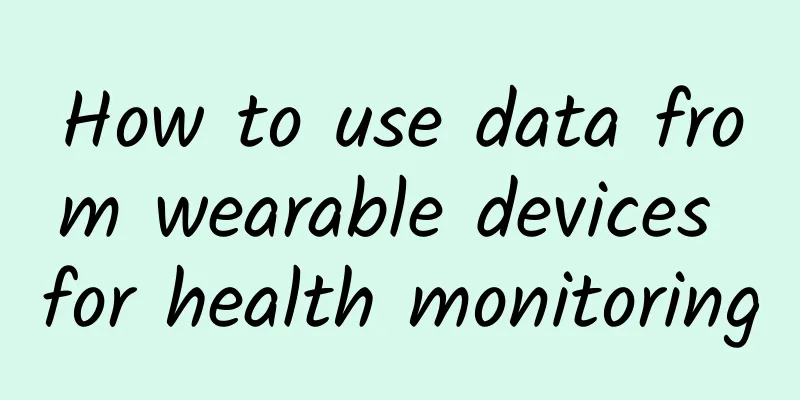How to use data from wearable devices for health monitoring

|
【51CTO.com Quick Translation】 With the advancement and development of technology, health-related data is growing day by day. Traditionally, this data is usually generated in the medical and health system, which collects information about patients. Some common sources include patients' health records, video/audio examinations, known diseases, and routinely used drugs. Every time a patient receives medical services, whether it is an appointment for examination or an emergency visit, more data will be generated, thereby improving the accuracy of tracking the patient's condition. This health monitoring model can build personalized data to support various preventive measures related to the patient's diagnosis, treatment, and rehabilitation. However, it also has the limitation of dependence on medical centers. If the patient does not receive some services, no consistent data will be generated. The increasing use of wearable devices has provided a new perspective for monitoring people's health. The expansion of telemedicine has also played a facilitating role, especially in the context of the adoption of the "continuity of care" concept. The introduction of these technological solutions into preventive measures in medicine has led to an explosion in the amount of data collected. This is why big data technologies are being explored in many aspects in this context. "Given the availability of wearable devices, smart wearable personal systems should be lightweight, low power, affordable, operable by unskilled personnel, and have embedded processing and alarm capabilities," Lymberis explained. Most of the wearable devices launched in the market fit this description. In addition, some of these devices only provide a certain function, while some devices provide multiple functions integrated, such as fitness tracking, health monitoring and message display. The BASIS watch worn on the wrist is such a device that can track the wearer's heart rate and provide information about health and wellness. Other types of wearable devices include smart belts, smart clothing, activity trackers, smart glasses, etc. Industry manufacturers have developed different wearable devices for various application scenarios Wearable health devicesA research report published by industry experts Dian et al. highlights the importance of wearable health devices. The report identifies four clusters of wearable applications based on IoT technology, and wearable health devices are one of them. The other three are activity recognition and sports devices, tracking and positioning devices, and security devices. Wearable health devices are devices that collect health-related data using sensors. The research report also categorizes sensors based on the type of signals they monitor:
In applications, wearable devices perform preliminary calculations before sending data over the internet, followed by subsequent additional analysis, and alternative processes are found in many devices that are able to connect to smartphones. In these cases, there is an interaction between the wearable device and the mobile application. In general, such applications can visualize data from health devices. More specialized applications are also able to provide advice about the user's health. In scenarios involving smartphone intermediary operations, a common component is access to cloud-based services. The data collected by the wearable device is transmitted to those services where it is stored, processed, and analyzed. Wearable health devices can also be divided into two major categories: health treatment and rehabilitation and health monitoring. Health treatment and rehabilitation devices help improve the physical and mental health of patients. A research report published by industry experts Nave and Postolache describes innovative examples of such devices. The report states that a new type of smart walker can provide assistance to those with limited mobility. It is part of a physical therapy system that monitors patients in real time. The architecture of the smart walker is centered on a microcontroller that can interface with cloud services via Wi-Fi or 3G/4G protocols, and can adopt mobile applications via Bluetooth when the Internet is not available. Through these two interfaces, the smart walker sends data on the user's movements, allowing physical therapists to analyze the information and help exercise accordingly. The cloud computing environment stores all data in a MySQL database, and the web application accesses the data to provide another way of visualization. Because the data is stored in the cloud, the mobile application can keep running in sync when the Internet signal is available. The left picture shows a schematic diagram of the smart walker, which consists of the following components: RFID (1), IMU direction sensor (2), pressure sensor (3), distance sensor (4), Wi-Fi device (5), and Bluetooth device (6). The right picture shows the prototype of the smart walker Another example of a wearable device designed to help people with treatment and rehabilitation is an idealized smart wearable armband. This device does not use any other connection to the cloud service, as mentioned above. Instead, the smart wearable armband can record and pre-process and transmit the signal to another smart training device wirelessly. The other smart training device runs the trained machine learning algorithm offline. Once the correct movement is recognized, the training device sends the result to the gesture function embedded in the wearable armband. This module is responsible for simulating the user's gestures in real time. The accuracy of the gestures it recognizes makes it possible to translate the user's hand movement intention into precise gesture commands. Smart wearable armband prototype Health Monitoring Wearable health devices mainly implement monitoring to detect abnormal behavior in certain physiological body functions. A useful example is the wearable device that uses IoT technology to measure heartbeats mentioned in the research report by Jayanth et al. The report states that the system is designed to help family members and doctors of patients effectively monitor the health of patients and alert them in emergency situations. These devices identify heartbeat thresholds, such as "minimum and maximum values" when they are turned on. After that, every time an abnormal heart rhythm is detected, the system searches for the nearest available Wi-Fi and connects to it. Once the connection is established, it will notify family members and doctors of the abnormal heart rate by sending an email. At the same time, the wearable device triggers a vibrator to alert the user. Prototype of a printed circuit board (PCB) device for measuring heartbeat The concern about heart health has led to the development of many other wearable devices. One of them is a network system based on smart IoT with multiple sensors designed by experts such as Majumder. The system is categorized as a multi-sensor because it collects data from the user's pulse and temperature. The wearable hardware is responsible for capturing the data and sending all the information to the Android application. This communication takes place over a Bluetooth network that minimizes power consumption. The mobile application processes the data sent by the device and plots the ECG signal and body temperature in real time. The identification of abnormal patterns is based on some previously defined parameters (such as heart rate). Once the data collected by the wearable device reaches a certain threshold, the system sends a warning to the subject in the form of a message or vibration alert. The Android application does not require the user to keep any records about their health status as it immediately warns the user of any detected abnormality. Prototype of wearable smart IoT device Other types of wearable devices are disrupting the progress in health monitoring. They are designed to collect data from the user's body, which is why they are classified as ingestible devices. In their published research paper, Sargunam and Anusha describe a smart drug that can generate information about blood sugar levels using infrared radiation. The technology is a non-invasive way that can help diabetics monitor their blood sugar levels. Its radiation signal is captured by a mobile medical application on a smartphone. Since the concentration of glucose in the blood depends on the intensity of a specific wavelength of radiation, the mobile application can monitor it using a wireless channel. Yoshida et al. designed a flat-plate-shaped ingestible core body temperature sensor based on gastric acid power generation for daily health care. They designed a device prototype with a size of 10 mm × 8 mm using a custom integrated circuit. The device is able to encode, modulate and transmit data about body temperature based on the power of gastric acid. Its data can be successfully received and correctly decoded by an antenna 20 cm away. Wearable health devices face challengesAs wearable technology evolves, wearable health devices also face unique challenges. Experts point out that "tablets and smartphones evolved from the computer era and their functions and form factors are more standardized, while the design and development of wearable devices are driven by many different market segments and therefore have more diverse forms." Wearable health devices are also affected by this reality. Lymberis mentioned this sign. He said, "There is no smart wearable system on the market that can integrate multiple sensors, intelligent processing and alarm functions to support medical decision-making and can easily interact with medical institutions at any time." Taking this into account, some common challenges of wearable health devices are reported in the professional literature. The data resolution of the sensors is one of the challenges. Typically, wearable devices must be small, comfortable to use, and consume less power. These requirements have a direct impact on the resolution they achieve, especially when compared to other types of devices. For wearable health devices, the focus is usually on the patient, and the quality of data visualization can be a more complex trade-off in meeting the above requirements. For problems involving data interpretation, power consumption and wearability are two other challenges. Wearable health devices must operate for a long time, as their role is mainly to monitor the user's information or support rehabilitation, and minimize the number of battery changes. Industry experts have explored a mechanism based on flexible solar collectors for this purpose, and they use multi-sensor health wearable devices that can work autonomously for 24 hours. The trade-off between computational complexity and weight of wearable devices is one of the major challenges. This has to be taken into consideration in the design of such devices as consumers will be more likely to adopt fashionable wearable devices. Some research reports also mention security as a typical challenge for health wearable devices. Security is related to the level of RF exposure of users wearing such devices. According to a research report published by Vahidnia and Dian, the high level of RF exposure can be due to the close proximity of antennas used by Cellular Internet of Things (CIoT) solutions. The security of the data manipulated by these devices is another concern. It is often implemented in these devices that are not conducive to the adoption of strong security strategies. There is also a case for introducing encryption-based data protection, which makes wearable devices vulnerable to hacking. The lack of proper regulations is considered another obstacle to the widespread use of wearable devices. Although health devices are not greatly affected by this issue, other fields have also been deeply affected. The use of wearable devices in sports is an example, but the application of wearable devices is hindered by the lack of specific standards. In terms of security, data privacy of wearable devices is a challenge that is often addressed. The threat stems from the fact that wearable devices usually use broadcast mode to communicate, which helps unauthorized devices capture users' private data. From the perspective of health data analysis, the maximum amount of data generated by wearable devices is stored in isolated IT systems or multiple cloud solutions. This reality poses a barrier to the adoption of complex analysis based on business intelligence. Therefore, users lose a lot of more valuable information due to the lack of feedback based on merged data. Industry experts point out that “while end users can still benefit from the collected data, a greater impact will be felt when this data is anonymously combined with other data for intelligent scenario processing.” In order for healthy wearables to achieve higher user satisfaction, industry expert Lymberis lists four other features to supplement what must be addressed. First, he advocates that patients should be able to input data into wearable devices. Second, it is necessary to establish a link between the device and the health provider. Third, through "special medical algorithms" to integrate medical data received from multiple sensors. Fourth, develop a validation plan to submit smart wearable applications to complex clinical scenarios. Wearable health devices and big dataIndustry expert Chen said, "Sustainable health monitoring has a close relationship with health big data." They put forward two arguments to support this statement. The first is related to data collection. Effective health monitoring depends largely on continuous and long-term data capture. The second is about cloud computing intelligence used to support health big data analysis. Proper acquisition of the amount of health data generated from the population is very important for optimizing public or private health services. There is also the use of the human area network (BAN) as a mechanism for collecting large amounts of health data. Associated with these collectors, applications for big data processing must be available in a cloud computing environment and must operate on the captured data. System architecture based on health monitoring of smart clothing Smart clothing for continuous health monitoring can demonstrate the feasibility of this architecture. Wearable smart clothing consists of multiple sensors: pulse sensor, body temperature sensor, electrocardiogram sensor, myocardial sensor, blood oxygen sensor, electroencephalogram sensor and battery. This is the first component of the mobile health cloud computing software system. All collected data is sent to the mobile application (the second component of the system), which displays the user's health status in real time. The communication is carried out through a low-power channel. The third component is a cloud computing service that receives the data forwarded by the smartphone application. The API for big data analysis provides functions for data statistics and machine learning libraries that help predict the health trends of users. Specifically, Hadoop and Spark technologies are used for batch processing, and Storm is used for stream processing. For machine learning algorithms, they used the implementations available in Spark MLlib and Mathout libraries. And three web applications were developed on this infrastructure: one for health monitoring, another for emotional comfort, and another for human-computer interaction. Through data integration, the potential of big data generated by health wearable devices can be thoroughly explored. The core work is based on the concept of "ontology" to provide wearable knowledge as a service (KaaS) in the medical field, which is designed to handle the heterogeneity of wearable data to ensure semantic interoperability and allow the creation of more accurate knowledge about patients. All concepts captured by the ontology are mapped to classes representing the domain of wearable devices. For example, a "parameter" general class is defined to indicate the nature of the monitored data. Parameters such as "glucose", "blood pressure" and "heart rate" are some specialized subclasses. This validates the strategy of applying the developed ontology to monitor the condition of diabetic patients. in conclusionSignificant progress has been made in the research of wearable devices. This has brought more opportunities to explore such technologies in many different situations. A similar trend has been found from the perspective of wearable health solutions. However, the various approaches and strategies involved in new applications have brought some challenges, especially the large amount of data collected using wearable devices faces problems related to interoperability. In the future, there will be more innovative technologies and applications to improve medical services and patient health. Original title: Health Monitoring Through Data From Wearables, author: Thiago Nascimento [Translated by 51CTO. Please indicate the original translator and source as 51CTO.com when reprinting on partner sites] |
<<: Android WeChat 8.0.2 official version released: 7 surprising changes
Recommend
J-20, J-10CE, Xiaolong, H-6K... the "phalanx" of domestically produced aircraft unveiled at the Paris Air Show
Recently, at the 54th Paris Air Show, the "C...
Uncle Wolf’s virtual online course project earns over 10,000 yuan a month. Here is a video tutorial of the virtual online course project operated by Uncle Wolf himself!
Let me briefly explain to you the essence and log...
8 key points for the fission of 6 distribution activities!
If you only want to see the conclusion (pitfall),...
Several hidden functions in WeChat on mobile phones, learning them is very practical
[[399052]] WeChat has become an indispensable too...
WeChat Moments Advertising- Charging Strategy
Moments ads support two purchasing methods: sched...
Written on the day Wen Xin Yi Yan was released
I was on a business trip recently because of the ...
Kaola.com Product Analysis Report
Kaola.com focuses on the cross-border e-commerce ...
Full set of VIP paid SEO training for the entire network with black hat SEO tutorial
Full set of VIP paid SEO training for the entire ...
WeChat 8.0.8 is here, you can enjoy a 10% discount by using WeChat to recharge on App Store!
Recently, WeChat quietly pushed the iOS WeChat 8....
Deloitte: Brexit will lead to a job crisis in the German automotive industry
According to foreign media reports, a hard Brexit...
From 0 to 1, how to engage in product operations in the field of Internet finance?
Recently, there have been frequent "explosio...
These 100 classic copywriting sentences can instantly catch your eye and make you feel excited.
Good copywriting can instantly catch the eye, gri...
Opening a Baidu promotion framework account can help you save a lot of bidding fees and let your information dominate the Baidu search box!
Baidu framework account opening can help you save...
Product operation, how to cross-border thinking?
In the process of career change or operational gr...
Honor Play 7X review: A flagship phone worth 1,000 yuan with full screen performance
Honor Play 7X was just released on the afternoon ...









